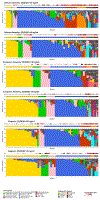Relationship between vitamin D status and the vaginal microbiome during pregnancy
- PMID: 30858609
- PMCID: PMC6535112
- DOI: 10.1038/s41372-019-0343-8
Relationship between vitamin D status and the vaginal microbiome during pregnancy
Abstract
Objective: Evidence supports an inverse association between vitamin D and bacterial vaginosis (BV) during pregnancy. Furthermore, both the vaginal microbiome and vitamin D status correlate with pregnancy outcome. Women of African ancestry are more likely to experience BV, to be vitamin D deficient, and to have certain pregnancy complications. We investigated the association between vitamin D status and the vaginal microbiome.
Study design: Subjects were assigned to a treatment (4400 IU) or a control group (400 IU vitamin D daily), sampled three times during pregnancy, and vaginal 16S rRNA gene taxonomic profiles and plasma 25-hydroxyvitamin D [25(OH)D] concentrations were examined.
Result: Gestational age and ethnicity were significantly associated with the microbiome. Megasphaera correlated negatively (p = 0.0187) with 25(OH)D among women of African ancestry. Among controls, women of European ancestry exhibited a positive correlation between plasma 25(OH)D and L. crispatus abundance.
Conclusion: Certain vaginal bacteria are associated with plasma 25(OH)D concentration.
Conflict of interest statement
CONFLICT OF INTEREST
The authors declare no conflicts of interest.
Figures





Similar articles
-
Total and Free 25-Hydroxy-Vitamin D and Bacterial Vaginosis in Pregnant African American Women.Infect Dis Obstet Gynecol. 2019 Jan 1;2019:9426795. doi: 10.1155/2019/9426795. eCollection 2019. Infect Dis Obstet Gynecol. 2019. PMID: 30692844 Free PMC article.
-
The vaginal microbiome as a predictor for outcome of in vitro fertilization with or without intracytoplasmic sperm injection: a prospective study.Hum Reprod. 2019 Jun 4;34(6):1042-1054. doi: 10.1093/humrep/dez065. Hum Reprod. 2019. PMID: 31119299
-
Treatment of vitamin D deficiency is an effective method in the elimination of asymptomatic bacterial vaginosis: A placebo-controlled randomized clinical trial.Indian J Med Res. 2015 Jun;141(6):799-806. doi: 10.4103/0971-5916.160707. Indian J Med Res. 2015. PMID: 26205023 Free PMC article. Clinical Trial.
-
Vaginal microbiome.Ceska Gynekol. 2018 Winter;83(5):371-379. Ceska Gynekol. 2018. PMID: 30848142 Review. English.
-
Vaginal microbiome: normalcy vs dysbiosis.Arch Microbiol. 2021 Sep;203(7):3793-3802. doi: 10.1007/s00203-021-02414-3. Epub 2021 Jun 13. Arch Microbiol. 2021. PMID: 34120200 Review.
Cited by
-
Diversity of Vaginal Microbiome in Pregnancy: Deciphering the Obscurity.Front Public Health. 2020 Jul 24;8:326. doi: 10.3389/fpubh.2020.00326. eCollection 2020. Front Public Health. 2020. PMID: 32793540 Free PMC article. Review.
-
Life History Recorded in the Vagino-cervical Microbiome Along with Multi-omes.Genomics Proteomics Bioinformatics. 2022 Apr;20(2):304-321. doi: 10.1016/j.gpb.2021.01.005. Epub 2021 Jun 9. Genomics Proteomics Bioinformatics. 2022. PMID: 34118463 Free PMC article.
-
The Integrative Human Microbiome Project.Nature. 2019 May;569(7758):641-648. doi: 10.1038/s41586-019-1238-8. Epub 2019 May 29. Nature. 2019. PMID: 31142853 Free PMC article.
-
Group B Streptococcus and the vaginal microbiome among pregnant women: a systematic review.PeerJ. 2021 May 17;9:e11437. doi: 10.7717/peerj.11437. eCollection 2021. PeerJ. 2021. PMID: 34046261 Free PMC article.
-
A bibliometric analysis of global research on vitamin D and reproductive health between 2012 and 2021: Learning from the past, planning for the future.Front Nutr. 2022 Sep 8;9:973332. doi: 10.3389/fnut.2022.973332. eCollection 2022. Front Nutr. 2022. PMID: 36159484 Free PMC article.
References
-
- Tabatabaei N, Auger N, Herba CM, Wei S, Allard C, Fink GD et al. Maternal Vitamin D Insufficiency Early in Pregnancy Is Associated with Increased Risk of Preterm Birth in Ethnic Minority Women in Canada. J Nutr 2017; 147: 1145–1151. - PubMed
Publication types
MeSH terms
Substances
Grants and funding
LinkOut - more resources
Full Text Sources
Medical

